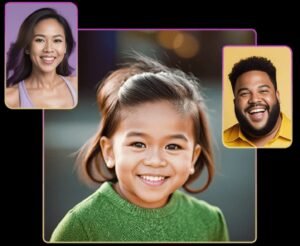Find your future Baby Face
How to Find your future Baby Face AI baby generators are software tools that use artificial intelligence to create images of what a couple’s future child might look like.
These tools analyze the facial features of both parents and generate a lifelike image of the potential baby.
Several popular AI baby generators are available, including:
Fotor: This user-friendly tool allows users to upload photos of themselves and their partner, choose the child’s gender, and generate a realistic image of their potential baby. Fotor is available on mobile devices.
Merlin AI: This tool offers a fun way to visualize a future child by merging facial features from uploaded photos. Users can even use celebrity images to create their baby’s image.
Future Baby: This free tool allows users to generate unlimited baby images by uploading clear photos. The AI analyzes features such as eye color and nose shape to create realistic results.
It is important to note that these generators are primarily for entertainment purposes and should not be used to make any serious decisions about parenthood.
They provide a playful glimpse into what a couple’s future child might look like but should not be taken too seriously.
AI-powered baby generators assert accuracy rates of up to 90%, but this claim should be treated with caution. These predictions are based on visual similarities and artistic interpretations, not scientific genetic analysis.
Therefore, they should be viewed as entertainment rather than reliable tools. The accuracy of these generators can vary significantly depending on the quality of the input photos and the sophistication of the algorithms employed.
While they offer a glimpse into potential future appearances, it is crucial to recognize that they lack scientific validation and cannot reliably predict a child’s actual physical characteristics.
AI-powered baby generators generally address genetic diversity by analyzing facial characteristics from both parents and employing algorithms to blend these features.

However, their efficacy in representing diverse genetic backgrounds may be constrained. Many generators rely on datasets that potentially lack
comprehensive coverage of various ethnicities and genetic traits, potentially resulting in biased or less accurate representations for individuals from underrepresented backgrounds.
While these tools aim to simulate genetic combinations, the intricate nature of real genetics—influenced by numerous factors beyond physical appearance—necessitates viewing them primarily as entertainment rather than precise predictors.
Hey there! Wanna have a little fun and see what our future baby might look like? It’s just for kicks, though. Remember, nature’s full of surprises, even siblings can look totally different.
This app doesn’t do any fancy genetic stuff, it just analyzes our faces and makes a prediction. So, don’t take it too seriously, okay? It’s all in good fun!
Here’s how it works:
1. Pick a photo of you and me.
2. Tell the app if we’re having a boy or a girl and how old they’ll be.
3. Hit the heart button and let the magic happen!
Oh, and the app has some other cool features too. You can make family photo collages, save your creations, and share them with friends. Enjoy!
AI-powered baby generators endeavor to mitigate bias through various methodologies, yet certain challenges persist.
These systems leverage Generative Adversarial Networks (GANs) trained on extensive datasets encompassing diverse baby images, aiming to capture a comprehensive spectrum of features and ethnicities.
However, if the training data lacks adequate representation from various backgrounds, the generated outputs may inadvertently perpetuate existing biases.
To promote fairness and transparency, developers are strongly advised to prioritize the utilization of diverse datasets and provide clear disclosures regarding any limitations.
This ensures that users comprehend that these tools are primarily intended for entertainment purposes rather than accurate predictions.
Continuous research and development are essential to refine these systems further and progressively reduce any remaining biases.
Developers employ various strategies to address potential biases in AI training data:
1. Bias Detection: Tools are utilized to identify and measure biases within datasets, aiding in understanding their origins and effects.
2. Data Augmentation: By incorporating diverse examples into the training data, developers strive to reduce biases and enhance model outputs.
3. Diverse Training Sets: Actively seeking data from varied demographics ensures representation and minimizes bias.
4. Human Oversight: Integrating human review assists in identifying and mitigating biases prior to deployment.
5. Continuous Monitoring: Ongoing evaluation of models in real-world applications enables adjustments to address emerging biases.
These practices are essential for developing fairer and more equitable AI systems.
Data augmentation is a technique used to reduce biases in AI models by artificially increasing the diversity of training datasets. This is achieved through techniques that
create synthetic data points, allowing models to learn from a broader range of examples, particularly from underrepresented groups.
Balancing Representation: By generating additional samples for minority classes, data augmentation helps balance the dataset, preventing models from favoring majority classes.
Enhancing Generalization: It exposes models to variations in data, reducing overfitting and improving their ability to generalize to unseen data, which is crucial for fair predictions.
Controlled Bias Introduction: Some methods intentionally introduce controlled biases to study and mitigate existing biases in datasets, promoting fairness in model outcomes.
These strategies collectively contribute to the development of more equitable AI systems.
BabyGenerator Guess Baby Face App User Guide.
Step 1: Upload Parent Photos
Select and upload high-quality, unobstructed front-view photos of both parents.
Ensure faces are clearly visible, without glasses or accessories.
Wait for few seconds
[su_button id=”download” url=”https://www.futurebaby.ai/” size=”6″ icon=”icon: arrow-circle-down” text_shadow=”0px 0px 0px #000000″]Ai baby generator App[/su_button]
Step 2: Select Child Preferences
Choose your desired child’s gender and age from the available options (e.g., “Boy 10,” “Girl 10”).
Step 3: Generate Baby Face Image
Press the heart button to initiate the AI image generation process.
The AI will analyze the parent photos and generate a predicted baby face image.
Disclaimer:
The BabyGenerator Guess Baby Face app is designed solely for entertainment purposes. The results generated by the app may not accurately reflect real genetic outcomes.